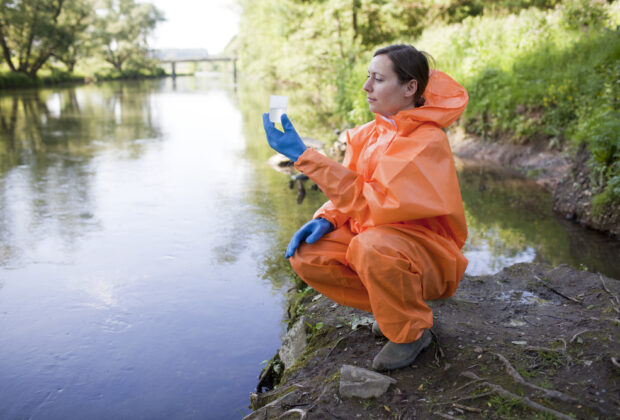Historical Overview of the Contamination
The Camp Lejeune water contamination crisis is a stark reminder of the potential hazards associated with military operations and their impact on human health and the environment. From the 1950s through the 1980s, the water supply at the United States Marine Corps Base Camp Lejeune in North Carolina was contaminated with hazardous chemicals at levels far exceeding safety standards.
Key contaminants included volatile organic compounds such as trichloroethylene (TCE), perchloroethylene (PCE), benzene, and vinyl chloride, which are known to have adverse health effects. These substances were primarily released from leaking storage tanks, industrial spills, and waste disposal sites within the base.
The contamination went undetected for decades, exposing military personnel, their families, and civilian workers to toxic chemicals. It was not until the early 1980s that the water contamination was discovered, leading to the closure of the affected wells. However, by this time, thousands of individuals had already been exposed to the contaminated water, setting the stage for a public health crisis that would unfold over the coming years.
Health Impacts on Veterans and Families
The water contamination crisis at Camp Lejeune has left a lasting impact on the health of veterans and their families. Prolonged exposure to the toxic chemicals found in the base's water supply has been linked to a variety of serious health conditions. These include, but are not limited to:
- Various forms of cancer, such as leukemia, bladder, and breast cancer
- Birth defects and negative outcomes in pregnancy
- Neurological disorders
- Liver and kidney damage
The ramifications of these health issues extend beyond the physical. Many survivors face emotional and psychological trauma, grappling with the stress of chronic illness and the financial burden of medical treatment. The crisis has also led to a sense of betrayal among veterans who feel that their service and sacrifice have been met with negligence. As the fight for recognition and compensation continues, the health impacts on these individuals and their families remain a central concern, underscoring the need for comprehensive support and remedial measures.
The Role of Government and Military Accountability
The government and military's role in addressing the Camp Lejeune water crisis is pivotal. Accountability measures are essential to ensure justice and support for the affected veterans and their families. The recent enactment of the PACT Act is a significant step towards acknowledging the suffering caused by toxic water exposure at the base. This legislation opens the door for thousands of veterans to file lawsuits and seek compensation for the health effects they have endured.
Key elements of the government's accountability include:
- Thorough investigation of the contamination's causes and impact
- Transparent communication with the public and survivors
- Provision of adequate healthcare and compensation for victims
Legal proceedings are complex, with specific evidence and legal steps required to be outlined for those seeking justice. The government's commitment to rectifying past wrongs and preventing future incidents is under scrutiny, as the nation watches how this crisis is managed and how those affected are treated.
Legal and Legislative Efforts for Justice
Current Status of Claims and Litigations
The ongoing legal battle for Camp Lejeune water crisis survivors has reached a critical juncture. As of the latest updates, numerous claims and lawsuits have been filed by veterans and their families seeking justice and compensation for the health issues caused by the contaminated water. The complexity of these cases is underscored by the varying degrees of illness and the extended time frame of exposure.
Key points in the current legal landscape include:
- A significant increase in the number of claims filed following heightened awareness and legislative changes.
- Ongoing litigations that are navigating through the intricacies of proving causation and liability.
- The establishment of a multidistrict litigation (MDL) to streamline the handling of numerous similar cases.
Survivors and their advocates continue to monitor the progress of these cases, as outcomes will set precedents for current and future environmental health-related litigations. The legal community remains divided on the potential outcomes, with some expressing cautious optimism, while others prepare for a protracted legal struggle.
Legislative Actions and the Camp Lejeune Justice Act
The legislative landscape for Camp Lejeune survivors has been significantly altered by the enactment of the Camp Lejeune Justice Act of 2022. This pivotal legislation represents a watershed moment, as it expressly allows victims of the water contamination tragedy to seek compensation from the federal government. The Act acknowledges the suffering and long-term health consequences faced by veterans and their families, and opens a path for restitution that was previously obstructed by legal barriers.
Victims now have a variety of legal options at their disposal. They can initiate lawsuits against the government for damages incurred due to the contaminated water supply. Additionally, there are specific benefits available through the Department of Veterans Affairs (VA) designed to support affected individuals. The Act has thus created a framework within which justice can be pursued, and it underscores the government's responsibility to those who served at Camp Lejeune and their loved ones.
The following points outline the key provisions and implications of the Act:
- Victims can file claims directly against the federal government.
- The Act provides a clear legal basis for lawsuits related to the contamination.
- VA benefits have been expanded to include health care for diseases associated with the contaminated water.
- The legislation has set a precedent for how similar cases might be handled in the future.
Advocacy Groups and Their Fight for Compensation
In the wake of the Camp Lejeune water contamination crisis, advocacy groups have emerged as pivotal players in the fight for justice and compensation for the survivors. These organizations work tirelessly to ensure that the voices of those affected are heard, and that they receive the restitution they deserve for the health issues they've endured.
- Advocacy groups provide legal support to survivors, assisting them in understanding their rights and the complexities of filing claims.
- They also lobby for policy changes, pushing for legislation that would benefit the victims of the contamination.
- Through public campaigns, these groups raise awareness about the crisis, garnering support and putting pressure on responsible entities.
Camp Lejeune survivors can seek damages for illnesses linked to water contamination. Legal counsel can help file claims for compensation and navigate the process effectively. The collective efforts of these groups not only aid in individual cases but also contribute to a larger movement for systemic change and accountability.
Supporting the Survivors: Health and Financial Resources
Medical Assistance Programs for Affected Individuals
In the wake of the Camp Lejeune water contamination crisis, a variety of medical assistance programs have been established to support the affected veterans and their families. These programs aim to provide comprehensive healthcare services tailored to address the unique conditions associated with exposure to the contaminated water.
- Veterans Affairs (VA) Healthcare Benefits: Eligible individuals can receive healthcare benefits through the VA, which includes treatment for conditions related to the water contamination.
- Specialized Treatment Programs: Certain medical centers offer specialized programs focusing on the long-term health effects of the contamination.
- Counseling and Mental Health Services: Recognizing the psychological toll, counseling and mental health services are available to help survivors cope with the trauma and stress.
Navigating these resources can be complex, and survivors are encouraged to seek assistance from VA representatives or advocacy groups who can guide them through the process of accessing the benefits they are entitled to.
Financial Aid and Compensation for Victims
The financial repercussions of the Camp Lejeune water contamination crisis have been profound, with many survivors facing significant health care costs and related expenses. Recognizing this, various forms of financial aid and compensation have been made available to victims.
- VA Benefits: Veterans and their families may be eligible for health care benefits and disability compensation through the Department of Veterans Affairs (VA) if they can prove their conditions are related to the contaminated water at Camp Lejeune.
- Disability Compensation: For those who have developed certain diseases presumed to be caused by the contamination, the VA offers disability compensation.
- Reimbursement Programs: Reimbursement for out-of-pocket medical expenses related to the contamination is also an option for those who qualify.
Efforts to provide financial support are ongoing, with legal actions and legislative measures seeking to expand the scope of compensation. Survivors are encouraged to stay informed about new developments and to seek assistance from advocacy groups that can help navigate the complexities of obtaining the aid they are entitled to.
Community Support Initiatives and Charitable Organizations
In the wake of the Camp Lejeune water contamination crisis, community support initiatives and charitable organizations have emerged as vital lifelines for survivors. These groups provide a range of services and support, often tailored to the unique needs of those affected by the contamination.
- Local Community Groups: These grassroots organizations offer emotional support, advocacy, and assistance in navigating healthcare and legal systems.
- National Charities: Larger charities contribute by funding research, raising awareness, and lobbying for policy changes.
- Veteran Service Organizations: These entities focus on the specific needs of veterans, offering specialized support and resources.
The collaboration between these various groups has been instrumental in providing a comprehensive support network. Their efforts not only address immediate needs but also work towards long-term solutions for those impacted by the crisis. The generosity and dedication of volunteers and donors continue to play a crucial role in sustaining these initiatives, ensuring that survivors do not face the aftermath alone.
Raising Awareness and Education
Media Coverage and Its Impact on Public Perception
The media plays a pivotal role in shaping public perception, especially in the context of environmental and health crises. In the case of Camp Lejeune, media coverage has been instrumental in bringing the water contamination issue to the forefront of national consciousness. Through investigative reporting and consistent exposure, the media has helped to amplify the voices of survivors and demand accountability from responsible parties.
However, the extent and nature of media coverage can vary significantly, with some outlets providing in-depth analysis and others offering only superficial treatment. The impact of this coverage on public perception is multifaceted:
- Increased awareness: As more stories are published, public knowledge about the crisis grows.
- Influence on opinions: Media narratives can shape how the public views the government's response and the plight of the survivors.
- Support mobilization: Effective coverage can inspire action and support for the affected individuals.
Despite the critical role of media, there are concerns about selective reporting and the potential for sensationalism. It is essential for coverage to be balanced and factual, ensuring that the public receives a comprehensive understanding of the crisis and its implications.
Educational Campaigns to Inform the Public and Stakeholders
Educational campaigns play a crucial role in bridging the knowledge gap between the affected communities and the broader public. These campaigns are designed to disseminate accurate information about the Camp Lejeune water crisis, its long-term health effects, and the rights of those impacted.
- Awareness Initiatives: A series of targeted initiatives aim to educate both the public and key stakeholders about the contamination's history and the ongoing struggles of survivors.
- Outreach Programs: Outreach programs work closely with veterans' groups, health organizations, and legal experts to provide comprehensive information on available resources and legal options.
- Information Dissemination: Through various media channels, including social media, educational materials are distributed to ensure widespread understanding of the crisis.
It is imperative that these campaigns maintain transparency and accuracy to foster trust and support for the survivors. The recent fraud warning issued by the Justice Department and Navy underscores the importance of vigilance in the dissemination of information, particularly regarding the legal avenues available under the Camp Lejeune Justice Act.
The Importance of Survivor Testimonies in Advocacy
Survivor testimonies play a pivotal role in advocacy efforts, providing a human face to the Camp Lejeune water crisis and compelling others to action. These personal accounts offer invaluable insights into the real-world consequences of policy failures and environmental neglect.
- Personal Impact: Testimonies highlight the personal struggles and health battles faced by survivors, making the crisis relatable and urgent to the public and policymakers.
- Credibility: First-hand experiences add credibility to the claims of negligence and the need for accountability, reinforcing the call for justice.
- Policy Change: Survivor stories can influence policy decisions by showcasing the direct effects of legislative action or inaction on individuals' lives.
By sharing their stories, survivors not only contribute to raising awareness but also help to build a collective narrative that can drive systemic change. It is through these voices that the true scope of the tragedy is understood, and the momentum for reform is sustained.
The Path Forward: Policy and Prevention
Improving Military Base Environmental Safety Standards
The imperative to enhance environmental safety standards on military bases has gained significant attention in the wake of the Camp Lejeune water crisis. Ensuring the health and safety of military personnel and their families necessitates a multi-faceted approach:
- Regular Monitoring: Implementing continuous and comprehensive environmental monitoring to detect contaminants early.
- Upgraded Infrastructure: Investing in modern water treatment facilities and infrastructure to prevent future contamination.
- Training and Education: Educating military personnel on environmental safety practices and the importance of reporting potential hazards.
- Transparent Reporting: Establishing clear channels for reporting environmental concerns and making the findings accessible to all base residents.
These steps are crucial for preventing future environmental health crises and fostering a culture of safety and accountability within military installations. The lessons learned from Camp Lejeune must inform policy changes and operational protocols to safeguard those who serve their country from similar exposures.
Policy Recommendations for Future Crisis Management
In the wake of the Camp Lejeune water crisis, it is imperative to establish robust policy frameworks to prevent similar tragedies in the future. Key recommendations include:
- Establishing Clear Environmental Oversight: Implementing stringent environmental safety protocols at military installations, with regular audits by independent agencies.
- Enhancing Crisis Response Mechanisms: Developing comprehensive emergency response plans that can be activated swiftly, ensuring timely and effective action in the event of environmental hazards.
- Investing in Infrastructure: Allocating funds for the modernization of water systems and infrastructure to meet or exceed safety standards, thereby reducing the risk of contamination.
- Fostering Transparency and Communication: Mandating transparent reporting of environmental conditions and potential risks to all base personnel and local communities, coupled with clear communication channels for reporting concerns.
- Strengthening Health Monitoring: Instituting ongoing health surveillance programs for military personnel and their families to detect and address health issues arising from environmental exposures early on.
These policy recommendations aim to create a safer environment for military personnel and their families, ensuring that the health risks associated with environmental hazards are minimized and that the well-being of those who serve is protected.
Strengthening Community Resilience and Preparedness
In the wake of the Camp Lejeune water crisis, the imperative to bolster community resilience and preparedness has never been clearer. Communities around military bases and other potentially hazardous sites must be equipped with the knowledge and resources to respond to environmental health crises effectively.
Key steps to enhance community resilience include:
- Establishing clear communication channels between military bases, local governments, and residents to facilitate timely information sharing.
- Implementing regular environmental safety drills and preparedness exercises to ensure readiness in the event of a crisis.
- Creating local emergency response teams that include veterans and community members, leveraging their unique insights and experiences.
- Encouraging local schools and organizations to incorporate environmental health education into their curricula and programs.
These proactive measures can significantly mitigate the impact of future incidents, ensuring that communities are not only prepared to respond but also equipped to recover swiftly. It is through such collective efforts that trust can be rebuilt, and a safer environment for all can be fostered.














